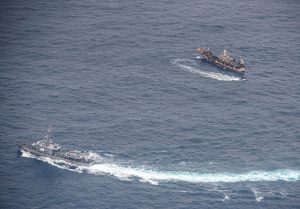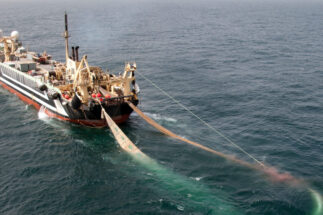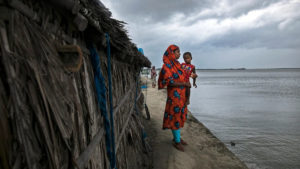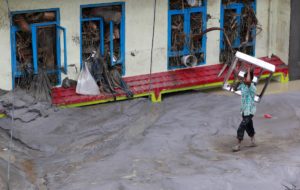It is almost midday in the northern Peruvian port city of Paita, near Ecuador. Although it is warm all year round, the winter is long and it’s windy enough to rock El Profeta de Dios, a small squid-fishing vessel about to set off.
Pedro Díaz and five other artisanal fishers have spent three days stocking the boat with food, ice for the hold, and the necessary tools to catch Humboldt squid (Dosidicus gigas), or pota, as they call it, in the Pacific waters. They only know the time of departure; the return is always uncertain. It can take between a week and a fortnight to complete the trip and return to the coast.
Fishing for Humboldt squid, or pota as they call it, has become the second-biggest fishing activity in Peru, in terms of catch volume and contribution to export revenues. In 2020 alone, Peru exported more than 297,000 tonnes, worth US$610 million. For years, the country has accounted for about half of the world’s landings of squid, according to UN Food and Agriculture Organization (FAO) data.
The abundance of squid also attracts foreign vessels. In August and September 2020, Chinese-flagged vessels hovered around the borders of Peru and Ecuador’s Exclusive Economic Zones, prompting an international outcry over alleged overfishing. Some months earlier, in June, the Bureau of Fisheries within China’s Ministry of Agriculture introduced a seasonal pota fishing ban for the period of September through November in the area to the west of Ecuador’s Galápagos Islands.
For small-scale fishers in northern Peru, unregulated fishing by national vessels is also a major problem. Coupled with the informality of the sector, which causes price variations and hampers conservation efforts, it means many no longer want to bank on making a living from the sea.
The squid boom in Peru
Díaz has been a fisherman for more than 20 years and is also a member of the Paita Humboldt Squid Association. He used to fish for hake and horse mackerel, but with the decline of these resources and the growth of the squid market, he saw an opportunity.
In Peru, the first official records of pota catches date back to 1964, but it was not until the 1990s that commercial fishing began. Over the years, a number of control and protection measures have been introduced, including the current Reglamento de Ordenamiento Pesquero (Fishing ordinance regulation) for squid. This regulation requires annual surveys to establish a harvest quota, set this year at 580,000 tonnes.
Díaz says his knowledge is the result of years of experience and information-sharing among fishers. He says that the artisanal sector needs specific regulations: “We don’t want to just fish and catch. We want to allow [the pota] to spawn and develop so that it generates employment and development for the state. We also want the pota to have a sustainable season. And what will those who come after us, the young people who are dedicated to fishing, find?”
Peru has no season closed to fishing and no minimum catch size for squid, but Díaz is uneasy about other existing regulations that he sees as punitive for artisanal fishers. “They control us to punish us, not to teach us how to conserve [the species],” he says. In a good season, Díaz can earn US$0.20 for every kilo of squid he catches, around half the price of a small bottle of Coca-Cola. Braulio Miranda, a fishing boat owner, says: “They [the government] demand a lot of documents from us. It’s good that there is regulation, but it’s very expensive for us. Sometimes there are fish and we catch them, sometimes we don’t, and the costs are too high. I ask the government to support artisanal fishers. Everything has gone up, fuel, food in general, but the price of squid is not going up.”
Formalisation remains a distant goal
Segundo Meza is 50 years old and does not want his children to follow in his footsteps, as he did his father’s. “Being an artisanal fisher is very hard work. There is no reward,” he says. Yet, despite his wishes, Meza’s eldest son, Alex, 21, is about to embark on his next fishing expedition.
Like Meza, who is a member of the Paita Port Union of Humboldt Squid and Deep Water Fishers (Sindicato de Pescadores de Calamar y Aguas Profundas del Puerto de Paita), generations of local families have maintained their ties to the sea. When he is not at sea, he manages the procedures for other fishers who are in the process of formalising their permit to extract marine resources. “The fisher is the one who goes out to sea to work, and he is the one who benefits the least,” says Meza.
Many Paita fishers say they are yet to see the benefits of a process of formalisation that began almost five years ago.
The fisher is the one who goes out to sea to work, and he is the one who benefits the least
The Peruvian Ministry of Production’s formalisation process involves two means of registration. One covers individual vessels, the other enables fishers to register through cooperatives. Despite repeated extensions of deadlines for registering all vessels, only 54% of individual vessels obtained their registration, and for those registered through cooperatives the figure is a lowly 11.2%.
“In these five months [from April to August] the number of permits granted has doubled, compared to the five years of the formalisation process for fishing cooperatives,” says Percy Grandez, a lawyer with the marine governance programme of the Peruvian Society for Environmental Law, an organisation that works with the production ministry on implementing the registration process.
If vessels do not formalise their status, they will not only be banned from fishing but also considered illegal in the country and in international waters. According to Grandez, “being an illegal fisher not only implies administrative responsibility and being subject to sanctions, fines or seizures, but it can also imply criminal responsibility.”
Vessels in international waters
“When we report [the presence of foreign vessels] they tell us to bring evidence. If we approach them, they withdraw. When the patrols arrive, there are no more boats. We don’t know if these fleets are legal or illegal,” says Díaz.
Measures to control foreign vessels are slowly being implemented in Peru, but other steps are also being taken, promoted by the international community.
The South Pacific Regional Fisheries Management Organisation (SPRFMO) was created in 2009 to regulate fishing in the region’s international waters. Among its most important measures is the authorisation of vessels to fish, as well as the implementation of a compatible satellite monitoring system and the presence of onboard observers.
According to the latest report by the SPRFMO’s Humboldt Squid Scientific Committee, there has been a steady increase in the Chinese fleet active in the southeast Pacific squid fishery over the past decade. In 2010, there were 104 Chinese vessels. While in 2019, there were 503. And according to the satellite tracking platform Global Fishing Watch (GFW), a total of 615 vessels – 584 of them Chinese – fished for squid in this area of the Pacific in 2020.
The GFW survey revealed the presence of unidentified vessels in the international waters between Tumbes and Piura. These were detected with radar designed for vessels that do not employ the conventional identification system or those that have chosen to transmit their location only intermittently.
In early 2020, China revised its Distant-Water Fisheries Management Regulations, introducing a blacklist for ship captains engaged in illegal, unregulated or unreported (IUU) fishing activities, along with stricter reporting requirements and onboard observers for trans-shipment vessels. It also created a legal obligation to report hourly transponder recordings, addressing concerns around vessel tracking: a further GFW analysis found that, prior to the regulation’s introduction, some Chinese vessels had manipulated or even turned off their satellite systems at the edge of Peru’s maritime borders.
For the first time, China’s fishing regulations refer to “sustainable development” and better control of its fleet size. The fisheries division of the Chinese Ministry of Agriculture followed these regulatory revisions with its June 2020 ban, which forbids fishing by Chinese vessels from September through November in the area to the west of Ecuador’s Galápagos Islands. The seasonal ban was reintroduced in September 2021, applicable to the same location. Its impact remains to be seen.
Supplying hard evidence also presents a challenge to confronting IUU activities, according to a fisheries specialist who has participated in several sectoral roundtables and prefers not to be identified. At the SPRFMO meetings, the specialist said, “Peru has not only failed to present substantiated complaints about cases of behaviour evidencing illegal fishing but has also failed to present proposals on sustainable management. This shows that they are not paying due attention to this resource.”
In a recent communiqué, the Peruvian Ministry of Foreign Trade and Tourism stated that “at present, Peru and China’s technical teams are working, through virtual means, on optimizing the Free Trade Agreement (FTA) between the two countries. Bilateral relations with China are extremely important.” The renegotiation of the FTA could provide an opportunity to establish stricter guidelines on the presence of the foreign fleet in Peru’s national waters, as well as environmental measures for the conservation of the species.
Juan Carlos Sueiro, fisheries director at the nongovernmental organisation Oceana, says that Peru should try to reduce foreign fishing in its national maritime territory. He adds that competition for squid could have an impact on the availability of the resource.
There has been a very big reduction in the number of Chinese vessels entering Peru
He also highlights the changes Peru has adopted in its own jurisdiction. In August 2020, it introduced a rule requiring foreign pota fishing vessels to use a Peruvian satellite tracking system if they want to use its ports. “What we have seen is that there has been a very big reduction in the number of Chinese vessels entering Peru,” he says.
From January to June, the National Port Authority registered only two Chinese vessels. Industry experts also say that China’s absence from international waters in the Pacific could also be an effect of last year’s media outcry involving its fleet, as well as China’s own tougher rules on illegal fishing.
In Paita, fishermen are still unsure of the effectiveness of China’s seasonal ban and how it will affect them. Their main concern is the precariousness of their income and the risk of not being able to fish, as they are faced with what they see as unfair competition in their waters. “They will say, ‘We won’t go for a few months,’ but when you least expect it, they are just around the corner,” says Meza.









